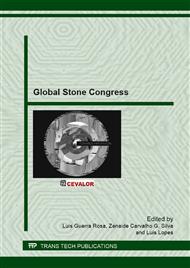p.197
p.205
p.212
p.220
p.231
p.239
p.247
p.255
p.267
On the Use of Thermal Properties for Characterizing Dimension Stones
Abstract:
The use of dimension stones in architecture and civil engineering implies the knowledge of several mechanical, physical, and chemical properties. Even though it has been usual practice to measure physical and mechanical properties of dimension stones the same is not true for thermal properties such as thermal conductivity, thermal diffusivity, specific heat capacity, and heat production. These properties are particularly important when processes related with heating and cooling of buildings must be considered. Thermal conductivity, thermal diffusivity, and specific heat capacity are related with the way thermal energy is transmitted and accumulated in stones; heat production has to do with the amount of radioactive elements in the rocks and so with the environmental impact of radioactivity and public health problems. It is important to start to measure on a routine basis those four thermal properties in rocks and, in particular, in dimension rocks so that their application can be improved and optimized. With this is mind three sets of different rock types (granites, limestones, and marbles) were collected to measure the thermal conductivity, the thermal diffusivity, and the specific heat capacity with the objective of characterizing them in terms of those properties. Since the same set of rocks has also been studied for other physical properties, a correlation amongst all the measured properties is attempted. For each rock type several samples were used to measure the thermal conductivity, the thermal diffusivity, and the specific heat capacity, and average values were obtained and are presented. As an example, for granites the thermal conductivity varies between 2.87 and 3.75 W/mK; for limestones varies between 2.82 and 3.17 W/mK; and for marbles varies between 2.86 and 3.02 W/mK. It is hoped that measuring thermal properties on dimension stones will help to better adequate them to their use in civil engineering as well as to adequate their use in terms of a CE product.
Info:
Periodical:
Pages:
231-238
Citation:
Online since:
April 2013
Price:
Сopyright:
© 2013 Trans Tech Publications Ltd. All Rights Reserved
Share:
Citation:


